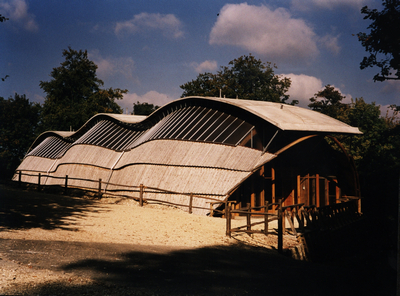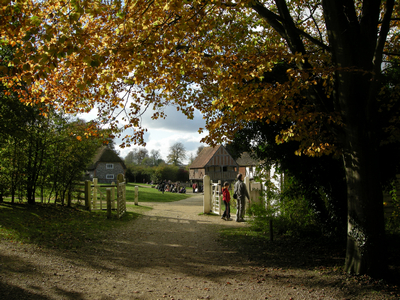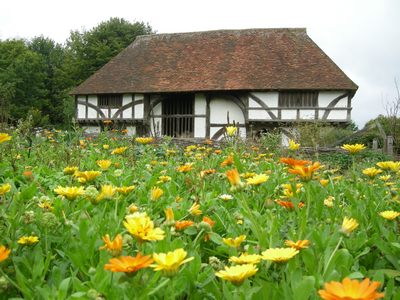Historic Building Conservation Project
In 2011 our museum of reconstructed historic buildings was honoured with a European Union Prize for Cultural Heritage / Europa Nostra Award in the Education, Training and Awareness-raising category and we were delighted to receive the Grand Prix. The jury, composed of independent experts from across Europe, commented that our award had been granted for the "exemplary initiative and long standing commitment of the Weald Downland Open Air Museum in creating a centre of training in historic building conservation". We were very pleased to have our training programme recognised on an international level, and proud of the practical role the Museum plays in sharing knowledge and skills from our inspiring site. The Museum hosted its own local ceremony to celebrate this Award in October 2011, as part of its annual conference for conservation professionals entitled ls"Seeing is Believing: Falsehoods in Architecture'.
 Our Museum: its origins
Our Museum: its origins
The tradition of open air museums in the UK is rooted in building conservation; in the preservation of historic, vernacular dwellings, agricultural buildings and places of work. The Weald Downland Open Air Museum was founded by Roy Armstrong, a visionary educator with a passion for teaching ordinary folk about the importance of their built heritage. Roy and other like-minded people cited the bonfires of medieval timber-framed buildings that they witnessed in the 1960s, and which were created in the cause of improved roads, town development, the creation of a reservoir and general dereliction, as the key issue that persuaded them that a museum of rescued vernacular buildings of the South East region of England was necessary. Vernacular buildings suffered gross neglect and these pioneers shared an appreciation of why the context of lower status buildings as well as castles and cathedrals is vital for our cultural heritage. Their enterprise resulted in setting up a charitable educational trust, and the Weald Downland Open Air Museum first opened to the public in 1970. From its inception over 40 years ago, the Museum has offered formal and informal learning opportunities dedicated to creating the next generation of skilled personnel for historic building conservation, while involving the wider public and a large number of volunteers through an inspirational learning environment. The use of the Museum's authentic rescued historic buildings as learning aids is key to the success of the courses.
Our Museum: today
There are now 50 historic buildings re-erected on the 20 hectare site, which provides a place of enjoyment and learning for the public and for students. None of our buildings had any future in their original sites. Understanding and conserving timber frames, and other associated building materials, became the central theme to the building conservation programme that has been developed at the Museum. The aims of the Historic Building Conservation programme are reflected in one of the four points of the Museums' mission statement: ls"to provide lifelong learning based on the museum's collections and other resources'. This theme fosters the philosophy of conservation, that historic fabric is important, that humble buildings have a social value, and that sensitive approaches to repair, quality and honesty in those repairs is vital. As part of the Museum's 40 year celebrations a conference entitled ls"Building Conservation comes of Age' took place; this brought together many pioneers of the building conservation movement from the UK and abroad with younger experts who are shaping the discussions today.
 Lifelong learning
Lifelong learning
Learning is a core activity of the Weald Downland Open Air Museum which has a long-established programme of training in many aspects of historic building conservation. The Museum provides a unique forum to bring expert practitioners and learners of all ages and backgrounds together in a setting where the exhibit buildings illustrate the points to be learnt. The Museum has always been a place where knowledge is shared. The programme started small; in 1998 there were a mere 150 student days of learning delivered. By 2011 we had grown ten-fold with around 1,500 days of student training in building conservation. We offer practical workshops in a wide range of topics, including timber framing, repair of historic brickwork, the use of lime and other issues in building conservation as well as teaching the theory and history which provide the under-pinning knowledge of the subjects. Students benefit from small group sizes, (typically 6 or 8 people for practical courses and 12 or 15 for lecture based days) which facilitates quality interactions with the tutor. Through minimising fees and offering bursaries we enable people from all walks of life to benefit from this specialist training. We also teach two Masters level degree programmes, in Building Conservation and Timber Building Conservation, validated by the University of York. As on the short courses, tutors are leading building conservation professionals and master craftspeople; all are practitioners in their respective fields, generous with their knowledge and share a gift for teaching. The scope of learning opportunities addresses a variety of needs. We aim to be responsive to current needs and offer bespoke training to a range of organisations.
Several qualities make this programme outstanding in the European context: firstly that the learning has been interwoven into a core function of the museum; training started here at a time when very little existed elsewhere. The on-going nature of the project and the fact that it is self-funding means that there is stability within the programme, a sense of continuity where participants know that they can contact the Museum or their tutors for advice informally after any course. Students can be confident in the standard of training they receive and the ability to return when time and finances allow to attend further courses to extend their knowledge. In addition, they can be confident that new developments, new research, new regulations, modern engineering solutions and energy conservation issues in conservation will be addressed.
 The future
The future
In 2002 the Museum built an award-winning modern conservation workshop, the Downland Gridshell. This revolutionised the scope of the building conservation training programme, in addition to enabling the Museum to undertake large scale conservation projects in a purpose built space. The latest addition to our historic building exhibits on site is a tin church, which was opened to the public in April 2011. Our own curatorial team undertook all the conservation work in the Downland Gridshell workshop. Another modern addition to the Museum is the Building Crafts Gallery, a very useful new room which is lined with panels displaying the tools and materials of many different craftspeople. These recent additions emphasise the fact that the Museum is looking forward to the next forty years of continuing to champion the cause of historic vernacular buildings. In September 2012 the frame of Tindalls Cottage, an early eighteenth century cottage, will be raised on the Museum site: this cottage will fill a gap in the chronological series of domestic buildings in the collection. The Museum will use the learning opportunities that these additional buildings provide, weaving the stories of the buildings, the techniques of their construction, the materials used, and the conservation work required to look after them, into its award-winning training programme.